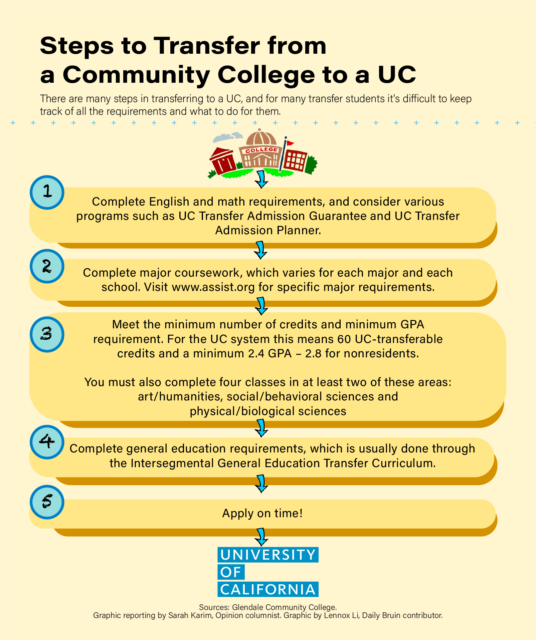“The Transfer Transition” is a series by Opinion columnist Sarah Karim, a fourth-year political science transfer student. These columns will explore various transfer experiences, from the application journey to the difficult process of transitioning to a new campus. The goal is to bring awareness to the unique struggles that transfer students face and to foster a deeper understanding of the transfer community.

Every college student can attest to the harrowing experience of college applications.
But for transfer students, it’s a process that can feel even more arduous.
Many transfer-track students aim to transfer out of community college within two years – a time in which they would need to complete a compelling application to a four-year school. Accounting for grades, extracurriculars and all of the other factors admissions offices will consider within the short timeline can leave many students juggling myriad requirements on top of their ongoing activities.
Without the right people to turn to, the transfer application process is a daunting task. That’s why resources for transfers specifically are so important; however, they can be difficult to come by.
Before the recent passage of Assembly Bill 928 and AB 111, which aim to consolidate transfer requirements across California’s public universities, transfer students would have to map out the course requirements for each school they planned on applying to.
While the bills help chip away at a process that can feel inaccessible, public institutions of higher education aren’t required to make immediate changes, so it’s difficult to know what the actual impact of the bills will be.
The timeline also leaves current transfer-track students in the same place as their predecessors.
Greg Grigoryan, a second-year undeclared student at Glendale Community College, said that he has felt extra pressure since deciding to apply for multiple majors at various schools.
“Honestly, (the requirements) are a mess. We kind of had to go through every single requirement and figure out which ones I’ll be able to complete this year and apply for those majors,” Grigoryan said.
He added that there are many inconsistent requirements across different schools.
For students applying straight out of high school, all majors are open regardless of the coursework they’ve taken. Transfers don’t get the same flexibility, forcing them to take extra and individualized steps for their desired major.
“For transfers, it’s kind of the opposite (of freshmen),” said Gary Clark, the director of Undergraduate Admission at UCLA. “Major plays a primary role in the review process. … (Transfer students) need to be able to jump right into the major that they’ve selected so that they can maintain the appropriate time to (complete their) degree.”
On top of the already confusing Intersegmental General Education Transfer Curriculum, which serves as a compilation of courses transfer-track students can take to satisfy general education requirements for California State University and University of California campuses, students are expected to complete the preparatory coursework for their major. Even if AB 928 and AB 111 are actually effective in creating more standardization in the UCs and CSUs, private universities will still have specific course requirements that aren’t coherent, forcing students to work harder for multiple schools that they may not end up attending.
This means that students should plan their coursework as far in advance as possible and continually check that they have understood every detail of the requirements at each university they hope to attend.
But that process is another obstacle on its own.
For Nathalie Guzman, a third-year sociology student at Pasadena City College, a lot of the planning process was done through her own research.
“I tend to want very specific answers that pertain specifically to me,” Guzman said.
She added that her school’s counseling department has been inefficient and difficult to get a hold of.
Without help, the transferring process becomes confusing, especially since community college students often face unique challenges and have various educational goals. Community colleges, UCs and CSUs should provide more opportunities for prospective transfer students to directly speak with advisors of their target schools or other resources to check that students are meeting all the correct requirements. Additionally, they should forge stronger connections with each other to make transferring more accessible.
Although the application process is currently quite difficult, many applicants can still agree that going to community college was the right choice for them. It gives them a valuable opportunity to take the time they need for themselves and tailor a specific educational path before fully committing to a four-year university.
“Community college just really prepares these students well in a really good environment and helps strengthen our characters before (sending us to) a four-year,” said Elza Vardanyan, a second-year economics student at Glendale Community College.
When it comes to the community college experience, there’s no right or wrong path.
“(The transfer experience) is very diverse – no path is the same,” said Aaron Tann, a fourth-year communication student and peer advisor for Community College Partnerships at UCLA. “A lot of students transfer in four, five, 10 years after being in community college. You’ve got students who kind of know about the pathway since high school (who) may transfer in one year.”
Attending community college is a valuable experience that gives students the opportunity to explore their interests and prepare themselves before entering a four-year institution. But after such a complicated application process, it would be a mistake to assume that community college is an “easy in” to universities.
With the right opportunities and resources, community college students have a chance of attending the college that’s right for them.
But it’s not always an easy journey to get there.

